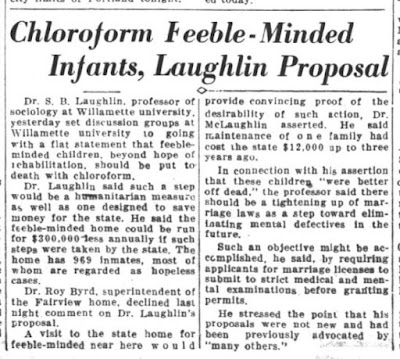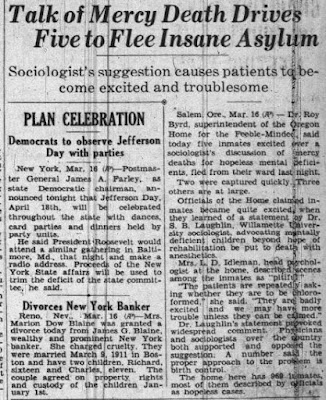In March of 1936, a year after the German Propaganda Eugenics Exhibit was popular here, a Willamette University Professor who had praised the exhibit crossed over a line with advocacy for infant euthanasia.
 |
| March 13th, 1936 |
Sceva B. Laughlin had come to Willamette in 1923.
 |
| August 14th, 1923 |
He died in 1947, and his obituary noted he was "a nationally known Quaker...prohibitionist, and a member of the Grange and Farmer's union." He had also been a Salem City Councilor.
 |
| August 16th, 1947 |
His obituary, however, was silent on the eugenics advocacy.
It seems comments he might have thought were contained to the classroom escaped containment and went public. The context in which he made the statements is not wholly clear. Maybe one or more people were just stirring the pot by amplifying the comments. The paper says only that he "set discussion groups going at Willamette university." Days later leaders at other schools asserted and understood the comments were informal, for the classroom, and not for wider public debate.
 |
| March 17th, 1936 |
Whatever was the initial context for his comments, the comments blew up and were not merely a controversy in Salem.
The AP picked up the story, sent out multiple installments, and papers across the country ran articles off the wire. Here are two, one from Texas, one from New York.
 |
| March 15th, 1936 Fort Worth (TX) Star-Telegram |
 |
| March, 17th, 1936 Buffalo (NY) Courier Express |
The controversy was no mere academic topic; it had real human costs. The Buffalo paper mentioned residents of Fairview fleeing, in fear for their lives. (It called them "inmates" rather than "patients" or "residents," and mentioned "capture," underscoring carceral themes.)
"The patients are repeatedly asking whether they are to be chloroformed," [head psychologist Mrs. L. D. Idleman] said. "They are badly excited..."One of the institutional responses was to withhold newspapers from residents, some of whom were able to read.
 |
| March 17th, 1936 |
At least some religious leaders protested.
 |
| March 17th, 1936 |
The stress was on the secular expert option, though.
Notwithstanding the Sociologists "firm" stand against the euthanasia and also the religious criticism, the papers here expressed support. The afternoon paper seemed more vocal, however. "Anesthesia is the remedy," they said.
 |
| March 13th, 1936 |
 |
| March 17th, 1936 |
Even with the opportunity afforded by two weeks distance for cooling off, the afternoon paper doubled down.
 |
| March 30th, 1936 |
At least one prominent business leader, Charles K. Spaulding of the Spaulding Lumber Company, made public his support.
 |
| March 21st, 1936 |
The controversy receded in memory. Though he did not seem to have apologized or walked-back his comments, maybe Laughlin just plain deserved the charity of forgetting about a mistake.
Institutional memory is silent.
Robert Moulton Gatke's 1943 Chronicles of Willamette mentions Laughlin only once, noting merely that he joined the faculty in 1923. Nothing else about him and nothing about the controversy.
In March of 1936 the student newspaper, The Collegian, doesn't seem to have anything either.
The Collection Guide to the Confederated Tribes of Grand Ronde Gallery at Hallie Ford Museum of Art mentions Laughlin's role only in passing.
In keeping with their times, collectors such as these did not record the voices of the makers or descendant communities but rather left the objects to speak for themselves. Now, these objects are being reanimated in dialogue with contemporary arts, artists, and scholars. Tribal attributions and approximate dates of manufacture for the baskets included in this gallery derive from an ongoing research process. One of the first Willamette professors involved in the creation of the collection in the 1920s to 1960s was sociologist Sceva B. Laughlin, who, along with his son William Sceva Laughlin, conducted archaeological excavations in the Willamette Valley.
Still, Laughlin appeared often in the newspapers here, giving lectures, in leadership for voluntary associations, and as City Councilor. He was not a nobody during his career.
The popularity of the German eugenics propaganda the year before in 1935 is certainly more significant as a cultural and political moment in Salem. With Laughlin's comments a year later, the newspapers might have blown an instance of careless, semi-private speech out of proportion. Even so, it's part of the larger cultural and political mood, and worth registering as a footnote, and perhaps as more.


No comments:
Post a Comment